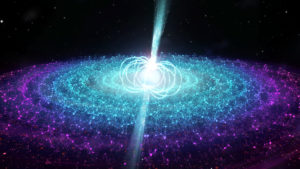A group of asotronomers have mapped the surface of a neutron star for the first time .NASA’s NICER instrument reveals that neutron stars are not as simple as we thought.

NICER
A neutron star fragment the size of a sugar cube (about a cubic centimeter) contains the same amount of mass as the entire human population. In fact, gravitational time dilation causes time on the surface of a neutron star to pass 30% slower than on Earth.
Neutron stars that rotate at high speed and emit pulses of radiation are called pulsars. Pulsars, like black holes, are extremely dense but extremely small objects .
Now, for the first time , astronomers have mapped the surface of a 25 km wide pulsar in exquisite detail. The result challenges astronomers’ textbook imagery of what a pulsar looks like and opens the door to learning more about these extreme objects .
From its position outside the International Space Station, the Neutron star Interior Composition Explorer, or NICER, searches for X-rays from extreme astronomical objects, such as pulsars.
In a series of studies published in The Astrophysical Journal Letters, the researchers used NICER to observe the pulsar J0030 + 0451, or J0030 for short, which is 1,100 light-years away in the constellation Pisces . Two teams, one led by researchers at the University of Amsterdam and the other led by the University of Maryland, observed the X-ray light from the J0030 over time to map the surface of the pulsar and measure its mass. Both teams arrived at an image that is not what they expected.
The measurement is challenging because, as noted, the pulsar’s immense gravity bends the spacetime around it, making the pulsar appear slightly larger than its actual size. Because NICER can record the arrival of the pulsar’s X-rays with extreme precision (100 nanoseconds), the researchers were able to map the star’s surface and measure its size with unprecedented precision .
Thus, NICER determined that the analyzed neutron star, J0030, is between 1.3 and 1.4 times the mass of the Sun. And it is approximately 26 kilometers wide. (By contrast, our Sun stretches a little over 1.3 million kilometers wide.)
The simple textbook image used to describe pulsars shows these objects with two hot spots, one at each of their magnetic poles. As the star rotates, the hot spots shoot radiation into space in thin beams, like a beacon. N ICER, however, has revealed that things are not so simple : J0030 has two or three hot spots, all in the southern hemisphere. The University of Amsterdam team believes that the pulsar has a small circular point and a thin crescent-shaped point that rotates around its lower latitudes. The University of Maryland team found that the X-rays could alternately come from two oval points in the southern hemisphere, as well as from a colder point near the star’s south pole.











